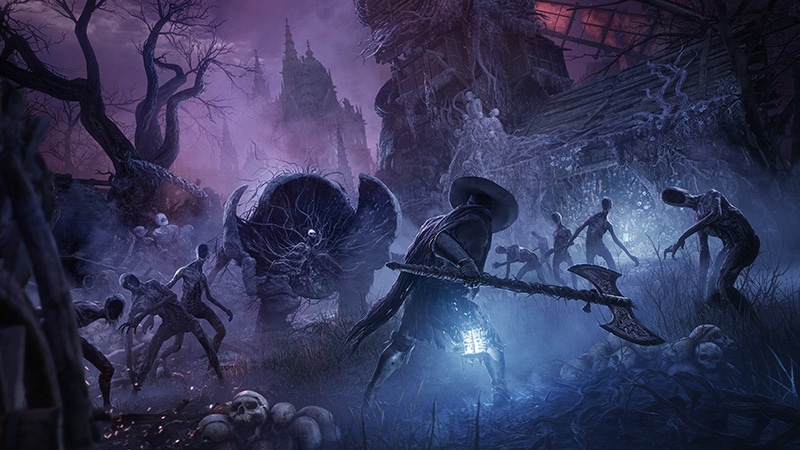Creating Lords of the Fallen's parallel world of Umbral
Hexworks studio head Saul Gascon discusses the process of building a parallel world that instills vulnerability.

Lords of the Fallen arguably wears its influences on its sleeve more overtly than most, though it would be unfair to say that this reboot of the 2014 game is merely following in the footsteps of the Dark Souls series. Besides its grim dark fantasy aesthetic, interconnected level design, and punishing combat encounters, its parallel worlds of Axiom and Umbral are unique.
On one hand, the idea of a change in the game state upon death has been inherent in FromSoftware’s games from the beginning. The studio introduced the world tendency system and the idea of the player character having human and soul forms in Demon’s Souls. Having similar consequences occur was something that Hexworks had wanted to introduce since the game’s inception, according to studio head and the game’s executive producer and studio head Saul Gascon.
“Our objective was to introduce innovation and add an intriguing dimension to the death loop, ensuring that when players faced defeat, something extraordinary would occur,” he explains. “However, initially, we grappled with uncertainty regarding what that 'something' should entail, prompting us to explore a plethora of possibilities.”
Rather than just a change of the player’s state upon death, Lords of the Fallen transforms the whole world as dying slips you from the land of the living to the land of the dead, featuring more hostile threats but sometimes new paths that were either not present or accessible before. More importantly, Umbral is actually running in parallel to Axiom simultaneously, such that when holding a special lantern, you can peer into the dark world.
Indeed, it was this mechanic that led the team realizing they could make something truly unique. “We subsequently reverse-engineered everything, building upon that core, yet astonishing, feature.”
Advanced shaders made Lords of the Fallen’s dual worlds possible
Executing this concept was a major technical challenge, considering the game is actually rendering two worlds simultaneously, and you have to be able to freely peer into the other world at any given time. An advanced shader was employed so that Umbral-exclusive objects would remain invisible in Axiom that would only become visible when either using the lamp or transitioning into the Umbral realm.
“Practically, our approach involved building Axiom first and then layering Umbral on top,” Gascon explains. “We conducted performance tests with both layers activated simultaneously, essentially the worst-case scenario in terms of performance, and made corrections where necessary.”
Adding to the challenge was the developer’s decision to switch from Unreal 4 to Unreal 5, which has reportedly been the reasons behind the game’s technical woes at launch, with a number of post-launch patches to improve the game’s performance and quashing bugs.
But on whether the switch presented new challenges, Gascon instead calls Unreal 5 “a blessing” in how it has been able to push the visuals to new heights. He acknowledges that this decision also meant a last-gen release would not have been feasible, at least not without completely overhauling the assets and sacrificing and the inability to use Unreal 5’s Nanite technology or Lumen lighting.
Umbral instills a sense of vulnerability
There’s another key distinction with the Umbral realm. Being in soul or hollow form in FromSoftware’s titles often puts you at a disadvantage, such as having certain features unavailable. But in Lords of the Fallen, there are often times when you have no choice but to commit to traversing into the undead realm, and that route is one-way until you can find and interact with an Emergency Effigy somewhere else. It also somewhat nullifies the game’s second-chance mechanic since by entering Umbral, you have already effectively 'died'.
It’s a deliberate and masochistic choice designed to make players feel more vulnerable and indeed Gascon deems it as crucial to have moments when sometimes the way forward means there’s no choice but to enter Umbral.
.jpg?width=700&auto=webp&quality=80&disable=upscale)
Image via Hexworks.
“During these moments, we intended for players to experience a palpable unsettling feel, prompting heightened vigilance as they entered Umbral to address the immediate challenges before them,” he explains. “This approach allowed us to intensify feelings of fear and tension, adding depth and excitement to specific points within the game's pace.”
This is similar to why your actions with the Umbral lantern are also limited, so that although you can peer into Umbral, some interactions such as pulling platforms closer aren’t possible, but enemies in Umbral can also drag you in.
“While the Umbral Lamp is indeed a powerful tool, we wanted to make the Umbral realm an unsettling and foreboding place,” Gascon says. “Our intention was to prevent players from feeling overly empowered while using the lamp and performing various actions. This deliberate approach aimed to maintain a necessary sense of respect for the ominous Umbral realm.”
Conversely, Umbral elements can also creep into the real world, as part of Hexworks’ vision of Umbral as not just a world but a Cthulhu-like entity permeating every aspect of the game. One such example are the Umbral parasites tethering themselves to enemies in Axiom, making them invincible until the player is able to destroy the parasite in Umbral. There’s many more of these nasty surprises lying in wait, although Hexworks has since also reined things in slightly, with one of the latest updates reducing enemy density by up to 30 percent.
Nonetheless, that sense of dread and vulnerability that you must steel yourself for remains core to Umbral’s design. “We wield these tools sparingly and thoughtfully, consistently reminding you that Umbral is an omnipresent force,” says Gascon.
“There will be times when you must confront it, whether you desire to or not.”
Read more about:
FeaturesAbout the Author(s)
You May Also Like









